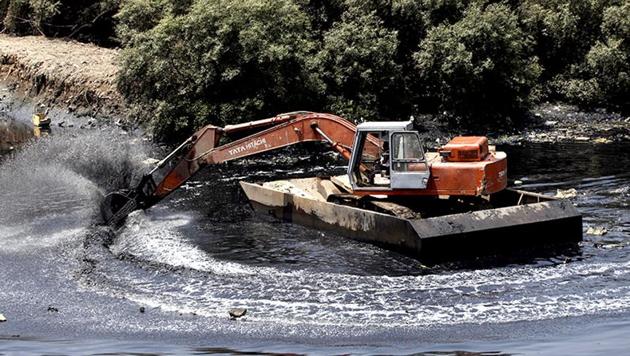15 years since plan for sewers, Mithi remains polluted
While it has been 15 years since the sewer lines were planned, the Mithi revival project is moving at a snail’s pace.
Maharashtra’s environment ministry recently announced plans to build two sewer lines along both the banks of the polluted Mithi river to intercept sewage and redirect it to sewage treatment plants (STPs).

While it has been 15 years since the sewer lines were planned, the Mithi revival project is moving at a snail’s pace.
Other cities, on the other hand, are doing better jobs at restoring their rivers. Kanpur, which is one of the biggest sources of untreated sewage flowing into the Ganga, has announced that it has diverted one of its largest drains from the river. Each day around 140 million litres of raw sewage including untreated effluents from leather factories, which used to flow in the drain, is being diverted to STPs where the water is treated to make it safe enough to be released into natural environment. Kanpur’s biggest drain, which used to pour effluents from tanneries and domestic waste into the Ganga, has finally run dry.
However, diverting one sewage drain will not end pollution in the Kanpur stretch of the Ganga. The city produces around 450 million litres of sewage per day and has treatment facility to deal with most of the sewage. However, the STPs are underutilised as most of the city is connected to drains that flow into the Ganga. Under the Namami Gange project, the city is expected to divert most of its sewage to STPs.
In comparison, Mumbai produces around 2,671 million litres of sewage daily, of which 2,016 million litres are treated in STPs while the rest is discharged directly into the sea; thus affecting water quality and marine life. Independent studies have shown that STPs are not equipped to deal with the chemicals released from tanneries.
After the flood of 2005 which killed more than a thousand citizens, the Maharashtra government had formed the Mithi River Development and Protection Authority for flood and pollution control. The state government claims it has spent over ₹1,150 crore to restore the 18-km-long river, but there is little on the ground to show that the money was used wisely.
Mithi was named the most polluted river in the state in 2018 with water quality parameters much above Central Pollution Control Board (CPCB) standards. Concrete embankments along the river – an idea criticised by environmentalists – have been built along the river’s lower reaches along Bandra-Kurla Complex (BKC) as well as near its headwaters at Vihar and Powai lakes.
The Mithi River Development and Protection Authority, chaired by the chief minister, is now defunct and Mithi continues to be Mumbai’s biggest conduit of untreated sewage into the sea.
Like the Ganga in Kanpur, a large part of Mithi’s waste is effluents from industrial units and waste processing units that line its banks. Mahim creek, into which the Mithi drains, is so polluted that it cannot sustain any aquatic life, says a study by the Indian Council of Agricultural Research (ICAR) - Central Institute of Fisheries Education (CIFE), Mumbai. The study found that faecal coliform (FC) — an indication of human and animal excreta, measured as colonies of coliform per 100 millilitre (ml) of water — was as high as 18,000/100ml, as opposed to the safe standards of 100/100ml. The study also found drug-resistant bacteria known as Escherichia-coli or E-coli — a microorganism widely found in the intestinal tract of humans — in the creek.
The pollution not only makes Mumbai’s beaches unsafe for swimming, but contaminates the seas enough to make it unfit for fishing as well.
Godfrey Pimenta from citizens’ group Watchdog Foundation, which has been tracking the progress of the Mithi restoration plan, said, “Implementation of the plan has been non-scientific. Sewage, right from Vihar, is sent directly to the river. There was a proposal for a STP (near what is now Bandra-Kurla Complex) in the 1967 Development Plan (DP) for the city. But the project has been deleted in the latest 2034 DP.”
Diversion of sewage from natural water bodies is the primary way to restore them.
In the 17th Century, as the industrial revolution led to an increase in population, London converted its Fleet and Walbrook rivers into sewers thinking this was the solution to the problem. But by mid-19th Century, the city’s main river, Thames, which received sewage from drains, had turned into a septic drain. The ‘Great Stink’ of 1858, when the British parliament was disrupted by stench from the river, led to the creation of the city’s sewerage network, which included sewers that ran parallel to the river intercepting waste.

Stay updated with all the Breaking News and Latest News from Mumbai. Click here for comprehensive coverage of top Cities including Bengaluru, Delhi, Hyderabad, and more across India along with Stay informed on the latest happenings in World News.
Stay updated with all the Breaking News and Latest News from Mumbai. Click here for comprehensive coverage of top Cities including Bengaluru, Delhi, Hyderabad, and more across India along with Stay informed on the latest happenings in World News.





